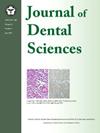纳米硅酸钙的生物矿化反应:降低牙本质过敏性的新方法
IF 3.4
3区 医学
Q1 DENTISTRY, ORAL SURGERY & MEDICINE
引用次数: 0
摘要
本文章由计算机程序翻译,如有差异,请以英文原文为准。
Biomineralization reaction from nanosized calcium silicate: A new method for reducing dentin hypersensitivity
Background/purpose
This study assessed the ability of experimental materials consisting of dicalcium silicate (DCS) and tricalcium silicate (TCS) with nanosized particles to form intratubular crystals under phosphate-buffered saline (PBS) and the effect on dentin permeability reduction.
Materials and methods
By isolating the cervical part of the extracted premolars, 195 specimens were obtained. Two experimental materials (DCS/TCS and TCS) were applied to the dentin surface by brushing and stored in PBS (n = 65). Another 65 specimens were not treated. Each group was randomly divided into five subgroups based on the PBS immersion period (1, 15, 30, 60, and 90 days, n = 10). The dentin permeability was measured, and the hydraulic conductance, Lp (%), was calculated. After acid challenge with 1 M acetic acid, Lp (%) was remeasured. Data were analyzed using two-way analysis of variance and Fisher's least significant difference test (α = 0.05). Three specimens of each subgroup were longitudinally sectioned and examined using scanning electron microscopy and a field emission-electron probe micro analyzer.
Results
The Lp (%) of the experimental groups gradually decreased over time (P < 0.05). The hydroxyapatite-like crystals that grew were observed and found to have a Ca/P ratio similar to that of hydroxyapatite. The crystals remained after the acid challenge, and the Lp (%) was not significantly different from that before acid treatment.
Conclusion
Intratubular crystals formed from the experimental materials consisted of DCS and TCS and were resistant to acid. These crystals significantly reduced dentin permeability.
求助全文
通过发布文献求助,成功后即可免费获取论文全文。
去求助
来源期刊

Journal of Dental Sciences
医学-牙科与口腔外科
CiteScore
5.10
自引率
14.30%
发文量
348
审稿时长
6 days
期刊介绍:
he Journal of Dental Sciences (JDS), published quarterly, is the official and open access publication of the Association for Dental Sciences of the Republic of China (ADS-ROC). The precedent journal of the JDS is the Chinese Dental Journal (CDJ) which had already been covered by MEDLINE in 1988. As the CDJ continued to prove its importance in the region, the ADS-ROC decided to move to the international community by publishing an English journal. Hence, the birth of the JDS in 2006. The JDS is indexed in the SCI Expanded since 2008. It is also indexed in Scopus, and EMCare, ScienceDirect, SIIC Data Bases.
The topics covered by the JDS include all fields of basic and clinical dentistry. Some manuscripts focusing on the study of certain endemic diseases such as dental caries and periodontal diseases in particular regions of any country as well as oral pre-cancers, oral cancers, and oral submucous fibrosis related to betel nut chewing habit are also considered for publication. Besides, the JDS also publishes articles about the efficacy of a new treatment modality on oral verrucous hyperplasia or early oral squamous cell carcinoma.
 求助内容:
求助内容: 应助结果提醒方式:
应助结果提醒方式:


